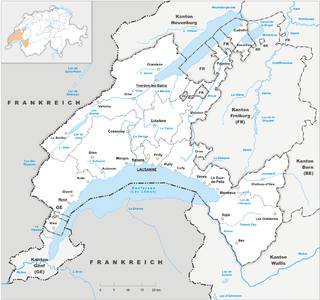
The canton of Vaud is the third largest of the Swiss cantons by population and fourth by size. It is located in Romandy, the French-speaking western part of the country; and borders the canton of Neuchâtel to the north, the cantons of Fribourg and Bern to the east, Valais and Lake Geneva to the south, the canton of Geneva to the south-west and France to the west.
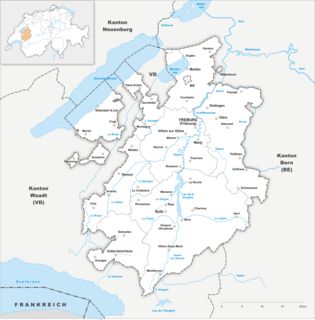
The canton of Fribourg, also canton of Friburg is located in western Switzerland. The canton is bilingual, with French spoken by two thirds of the citizens and German by about one third. Both are official languages in the canton. The canton takes its name from its capital city of Fribourg.
The Transports Publics Fribourgeois (TPF) is a renaming of the former Chemins de fer Fribourgeois Gruyère-Fribourg-Morat when the municipal Transport en commun de Fribourg (TF) was absorbed in 2000.
The Gruyère–Fribourg–Morat railway (GFM) was established with the merger in 1942 of two standard gauge and one 1,000 mm gauge railways running mainly within the Swiss canton of Fribourg. It was officially called the Compagnie des Chemins de fer fribourgeois. The company also operated numerous regional buses in the same area. After a merger with Fribourg city transport, the company was renamed Transports publics fribourgeois/Freiburgische Verkehrsbetriebe (TPF).
The West Switzerland Company was a railway company in Switzerland, formed 1854 and absorbed into the Western Swiss Railway in 1872. The OS built a railway network in western Switzerland and connected with France via Geneva in 1858, although Switzerland's first railway was the French Strasbourg–Basel Railway, which connected Basel with Strasbourg, France in 1844.

The Western Switzerland Railways, were initially a joint operation of three Swiss railway companies, but these companies merged on 1 January 1872. The company was called the Western Switzerland–Simplon Railways from 28 June 1881. The SOS merged with the Bernese Jura Railways to form the Jura–Simplon Railways on 1 January 1890.
The Jura–Simplon Railways (JS), was a railway company that was formed in 1890. It was nationalised in 1903 as the largest railway company in Switzerland and integrated into the Swiss Federal Railways (SBB).
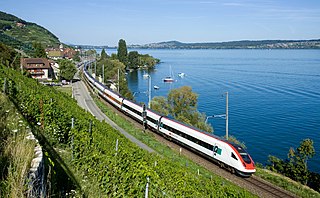
The Jura foot railway or Jura south foot line in Switzerland runs from Olten along the foot of the southern Jura range through Solothurn, Grenchen, Biel/Bienne, Neuchâtel, Yverdon-les-Bains and Morges to Geneva. It is one of two routes used by intercity trains between Geneva and Zürich. The other is the Midland line which connects Olten via Langenthal, Burgdorf, Bern, Fribourg, Lausanne to Morges. The line was built by five railway companies, which after several mergers were absorbed into the Swiss Federal Railways in 1903.
The Geneva–Versoix Railway is a former Swiss railway company that existed officially for only six days in 1858.
The construction and operation of Swiss railways during the 19th century was carried out by private railways. The first internal line was a 16 km line opened from Zürich to Baden in 1847. By 1860 railways connected western and northeastern Switzerland. The first Alpine railway to be opened under the Gotthard Pass in 1882. A second alpine line was opened under the Simplon Pass in 1906.

Palézieux railway station serves the village of Palézieux, within the municipality of Oron, in the canton of Vaud, Switzerland. The station is located at the junction of the standard gauge Lausanne–Bern and Palézieux–Lyss lines of Swiss Federal Railways (SBB), 20.6 kilometres (12.8 mi) from Lausanne. The station is also the terminus of the 1,000 mm gauge Châtel-St-Denis–Palézieux line of Transports publics Fribourgeois. Palézieux's other station, Palézieux-Village, is located to the north on the Palézieux–Lyss line.

Vallorbe railway station is a station at the border of Switzerland and France on the TGV Lyria line between Paris and Lausanne. It is located at the south-eastern entrance of the tunnel which tunnels one of Jura's mountain ranges, Le Mont d’Or. The station serves the municipality of Vallorbe, in the Canton of Vaud, Switzerland.
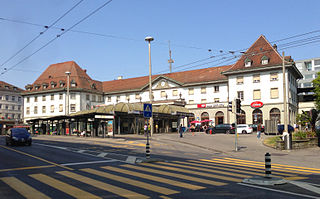
Fribourg railway station serves the municipality of Fribourg, capital of the canton of Fribourg, Switzerland. Opened in 1862, it is owned and operated by SBB-CFF-FFS.
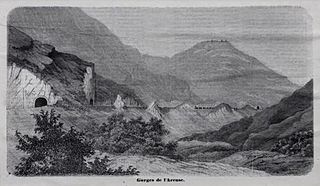
The Franco-Swiss Company was a former railway company in Switzerland, formed in 1859 and absorbed into the Western Swiss Railways in 1872. It built the Neuchâtel-Pontarlier railway.

The Lausanne–Geneva railway is a double-track main railway line in Switzerland. It is an important for passenger transport and is the most frequented railway in Romandy. It serves as an approach from Geneva to the Simplon Railway and the line to Bern and Zürich.

The Lausanne–Bern railway is a mainline railway in Switzerland. The first part of the line was opened in 1860 and the original line was completed on 4 September 1862. The line was built by the Swiss Central Railway and the Lausanne–Fribourg–Bern Railway, which were taken over by the Swiss Federal Railways on its establishment in 1902.

The Palézieux–Lyss railway is a single-track standard-gauge line of the Swiss Federal Railways (SBB) in Romandy.

The Fribourg−Yverdon railway is a single-track standard-gauge line of the Swiss Federal Railways (SBB) in Romandy.
The Fribourg–Ins railway is a single-track standard-gauge line in Switzerland operated by Transports publics Fribourgeois. It was built by the Chemin de fer Fribourg–Morat–Anet.

The Compagnie de la Ligne d’Italie, or Ligne d’Italie for short, was a former Swiss railway company that established in 1859. In 1874, the Ligne d'Italie became part of the Compagnie du Simplon. The Compagnie du Simplon, Ligne du Simplon or Simplon for short, merged into the Western Swiss Railways in 1881.
















